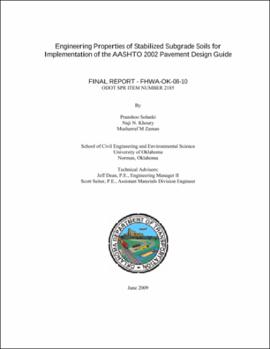| dc.description.abstract | A comprehensive laboratory study was undertaken to determine engineering properties of cementitiously stabilized common subgrade soils in Oklahoma for the design of roadway pavements in accordance with the AASHTO 2002 Mechanistic-Empirical Pavement Design Guide (MEPDG). These properties include resilient modulus (Mr), modulus of elasticity (ME), unconfined compressive strength (UCS), moisture susceptibility and three-dimensional (3-D) swell. Four different types of soils encountered in Oklahoma, namely, Port Series (P-soil), Kingfisher Series (K-soil), Vernon Series (V-soil), and Carnasaw Series (C-soil) were used in this study. These soils were stabilized with three locally produced and economically viable stabilizers used in Oklahoma, namely, hydrated lime (or lime), class C fly ash (CFA), and cement kiln dust (CKD). Additionally, mineralogical studies such as scanning electron microscopy, energy dispersive spectroscopy and X-ray diffraction were used to verify the findings from the macro test results. The percentage of stabilizer used (3%, 6% and 9% for lime; 5%, 10% and 15% for CFA and CKD) was selected on the basis of pH test and literature review. Cylindrical specimens of stabilized soil were compacted and cured for 28 days in a moist room having a constant temperature (23.0±1.7oC) and controlled humidity (>95%). The 28-day curing period is consistent with the new MEPDG for evaluation of design Mr, ME and UCS. After curing, specimens were tested for resilient modulus (Mr), modulus of elasticity (ME) and unconfined compressive strength (UCS). Selective specimens were also tested for moisture susceptibility (tube suction test) and three-dimensional swell during 60 days of capillary soaking. Results for the tested stabilized soil specimens showed that all three stabilizers improved the strength/stiffness properties, namely, Mr, UCS and ME values, of P-, K-, V- and C-soil specimens. At lower application rates (3% to 6%), the lime-stabilized soil specimens showed the highest improvement in the strength/stiffness. At higher application rates, however, P-, K, V- and C-soil specimens stabilized with 15% CKD showed the highest improvement. The P-soil specimens, however, showed more improvement in strength due to lower PI, as compared to K-, V- and C-soil. The SEM analysis showed formation of crystals with soil matrix as a result of stabilization. It is reasoned that the crystals within the matrix provide better interlocking between the particles and possible higher resistance to shear deformation and also reduce void within the matrix resulting in overall strength gain. The results of the analysis conforms to the results of the Mr, ME and UCS tests. The tube suction test (TST) results revealed that lime- and CFA-treatment is helpful because it reduces the moisture susceptibility. CKD-stabilization, however, makes stabilized specimens more susceptible to moisture, as compared to raw soil specimens. Three-dimensional (3-D) swelling test showed increase in volume for lime- and CKD-stabilized specimens while reduction in volume for CFA-stabilized specimen, as compared to raw soil. This increase in volume is attributed to sulfate-induced heaving which results in the formation of expansive mineral ettringite. Further, presence of ettringite was verified using SEM/EDS tests in conjunction with XRD analyses. This study generated useful information that would enrich the database pertaining to Mr, ME, UCS, 3-D swell and moisture susceptibility of selected soils in Oklahoma. An enriched database would benefit highway agencies, specifically pavement engineers, when dealing with construction of new pavements or rehabilitation of existing pavements. It will also facilitate the implementation of the new AASHTO 2002 pavement design guide. | |
